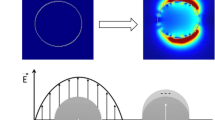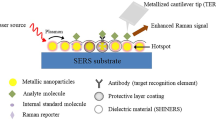Abstract
The shape-anisotropic metal nanoparticles support large surface plasmon resonance (SPR) wavelength tuning and higher intrinsic electromagnetic hot spots for excellent surface-enhanced Raman spectroscopy (SERS) performance. Here, two shape-anisotropic nanostructures, silver nanocubes and nanowires with sharp features and high yield, are synthesized using the polyol reduction method. Finite-difference time-domain (FDTD) simulations are performed to understand the origin of the SPR peaks in the absorption spectra and for optimization of excitation wavelengths for large near-field enhancement. Silver nanocubes and nanowires exhibit broad plasmon resonances over the visible region of the electromagnetic spectrum with maxima around 498 nm and 410 nm, respectively. The SERS activity of nanocubes and nanowires are investigated for three molecules of different Raman activity. The SERS spectra show higher activity for nanocubes and ultra-low molecular detection (10−15 M) capability of the fabricated substrates for rhodamine B (RhB) dye, p-aminothiophenol (PATP), and pesticide thiram. Relatively higher enhancement of some Raman modes is observed when excited with laser wavelength 532 nm indicating photo-induced charge transfer from metal to molecule.














Similar content being viewed by others
References
Ding G, Xie S, Zhu Y, Liu Y, Wang L, Xu F (2015) Graphene oxide wrapped Fe3O4@Au nanohybrid as SERS substrate for aromatic dye detection. Sensors Actuators B Chem 221:1084–1093
Zhang L, Jiang C, Zhang Z (2013) Graphene oxide embedded sandwich nanostructures for enhanced Raman readout and their applications in pesticide monitoring. Nanoscale 5:3773–3779
Andreou C, Hoonejani MR, Barmi MR, Moskovits M, Meinhart CD (2013) Rapid detection of drugs of abuse in saliva using surface enhanced Raman spectroscopy and microfluidics. ACS Nano 7:7157–7164
Das R, Soni RK (2017) Synthesis and surface-enhanced Raman scattering of indium nanotriangles and nanowires. RSC Adv 7:32255–32263
Dasary SSR, Singh AK, Senapati D, Yu H, Ray PC (2009) Gold nanoparticle based label-free SERS probe for ultrasensitive and selective detection of trinitrotoluene. J Am Chem Soc 131:13806–13812
Li M, Cushing SK, Wu N (2015) Plasmon-enhanced optical sensors: a review. Analyst 140:386–406
Tian F, Bonnier F, Casey A, Shanahan AE, Byrne HJ (2014) Surface enhanced Raman scattering with gold nanoparticles: effect of particle shape. Anal Methods 6:9116–9123
Si S, Liang W, Sun Y, Huang J, Ma W, Liang Z, Bao Q, Jiang L (2016) Facile fabrication of high-density sub-1-nm gaps from Au nanoparticle monolayers as reproducible SERS substrates. Adv Funct Mater 26:8137–8145
Schlücker S (2014) Surface-enhanced Raman spectroscopy: concepts and chemical applications. Angew Chem Int Ed 53:4756–4795
Reguera J, Langer J, Aberasturi DJ, Liz-Marzán LM (2017) Anisotropic metal nanoparticles for surface enhanced Raman scattering. Chem Soc Rev 46:3866–3885
Jana D, Mandal A, De G (2012) High Raman enhancing shape-tunable Ag nanoplates in alumina: a reliable and efficient SERS technique. ACS Appl Mater Interfaces 4:3330–3334
Seo SH, Kim BM, Joe A, Han HW, Chen X, Cheng Z, Jang ES (2014) NIR-light-induced surface-enhanced Raman scattering for detection and photothermal/photodynamic therapy of cancer cells using methylene blue-embedded gold nanorod@SiO2 nanocomposites. Biomaterials 35:3309–3318
Niu W, Chua YAA, Zhang W, Huang H, Lu X (2015) Highly symmetric gold nanostars: crystallographic control and surface-enhanced Raman scattering property. J Am Chem Soc 137:10460–10463
Lv ZY, Mei LP, Chen WY, Feng JJ, Chen JY, Wang AJ (2014) Shaped-controlled electrosynthesis of gold nanodendrites for highly selective and sensitive SERS detection of formaldehyde. Sensors Actuators B Chem 201:92–99
Rycenga M, Xia X, Moran CH, Zhou F, Qin D, Li ZY, Xia Y (2011) Generation of hot spots with silver nanocubes for single-molecule detection by surface-enhanced Raman scattering. Angew Chem Int Ed 50:5473–5477
Chen M, Zhang H, Ge Y, Yang S, Wang P, Fang Y (2018) Surface-nanostructured single silver nanowire: a new one-dimensional microscale surface-enhanced Raman scattering interface. Langmuir 34:15160–15165
Ben-Jaber S, Peveler WJ, Quesada-Cabrera R, Sol CW, Papakonstantinou I, Parkin IP (2017) Sensitive and specific detection of explosives in solution and vapour by surface-enhanced Raman spectroscopy on silver nanocubes. Nanoscale 9:16459–16466
Kodiyath R, Malak ST, Combs ZA, Koenig T, Mahmoud MA, El-Sayed MA, Tsukruk VV (2013) Assemblies of silver nanocubes for highly sensitive SERS chemical vapor detection. J Mater Chem A 1:2777–2788
Jiang T, Wang B, Zhang L, Zhou J (2015) Hydrothermal synthesis of silver nanocubes with tunable edge lengths and their size dependent SERS behaviors. J Alloys Compd 632:140–146
McLellan JM, Siekkinen A, Chen J, Xia Y (2006) Comparison of the surface-enhanced Raman scattering on sharp and truncated silver nanocubes. Chem Phys Lett 427:122–126
Wang L, Sun Y, Li Z (2015) Dependence of Raman intensity on the surface coverage of silver nanocubes in SERS active monolayers. Appl Surf Sci 325:242–250
Kwon J, Suh YD, Lee J, Lee P, Han S, Hong S, Yeo J, Lee H, Ko SH (2018) Recent progress in silver nanowire based flexible/wearable optoelectronics. J Mater Chem C 6:7445–7461
Becucci M, Bracciali M, Ghini G, Lofrumento C, Pietraperzia G, Ricci M, Tognaccini L, Trigari S, Gellini C, Feis A (2018) Silver nanowires as infrared-active materials for surface-enhanced Raman scattering. Nanoscale 10:9329–9337
Shi YE, Li L, Yang M, Jiang X, Zhao Q, Zhan J (2014) A disordered silver nanowires membrane for extraction and surface-enhanced Raman spectroscopy detection. Analyst 139:2525–2530
Wang C, Liu B, Dou X (2016) Silver nanotriangles-loaded filter paper for ultrasensitive SERS detection application benefited by interspacing of sharp edges. Sensors Actuators B Chem 231:357–364
Feng JJ, Liu L, Huang H, Wang AJ (2017) Poly(ionic liquid)-assisted one-pot synthesis of Au hyperbranched architectures for enhanced SERS performances. Sensors Actuators B Chem 238:91–97
Ankudze B, Philip A, Pakkanen TT, Matikainen A, Vahimaa P (2016) Highly active surface-enhanced Raman scattering (SERS) substrates based on gold nanoparticles infiltrated into SiO2 inverse opals. Appl Surf Sci 387:595–602
Yan X, Wang M, Sun X, Wang Y, Shi G, Ma W, Hou P (2019) Sandwich-like Ag@Cu@CW SERS substrate with tunable nanogaps and component based on the plasmonic nanonodule structures for sensitive detection crystal violet and 4-aminothiophenol. Appl Surf Sci 479:879–886
Li Y, Zhang K, Zhao J, Ji J, Ji C, Liu B (2016) A three-dimensional silver nanoparticles decorated plasmonic paper strip for SERS detection of low-abundance molecules. Talanta 147:493–500
Alsammarraie FK, Lin M (2017) Using standing gold nanorod arrays as surface-enhanced Raman spectroscopy (SERS) substrates for detection of carbaryl residues in fruit juice and milk. J Agric Food Chem 65:666–674
Zhang CH, Zhu J, Li JJ, Zhao JW (2017) Small and sharp triangular silver nanoplates synthesized utilizing tiny triangular nuclei and their excellent SERS activity for selective detection of thiram residue in soil. ACS Appl Mater Interfaces 9:17387–17398
Zhang Z, Yu Q, Li H, Mustapha A, Lin M (2015) Standing gold nanorod arrays as reproducible SERS substrates for measurement of pesticides in apple juice and vegetables. J Food Sci 80:N450–N458
Zhou N, Meng G, Zhu C, Chen B, Zhou Q, Ke Y, Huo D (2018) A silver-grafted sponge as an effective surface-enhanced Raman scattering substrate. Sensors Actuators B Chem 258:56–63
Alyami A, Quinn AJ, Iacopino D (2019) Flexible and transparent surface enhanced Raman scattering (SERS)-active Ag NPs/PDMS composites for in-situ detection of food contaminants. Talanta 201:58–64
Yang N, You T, Gao Y, Lu S, Yin P (2019) One-step preparation method of flexible metafilms on the water–oil interface: self-assembly surface plasmon structures for surface-enhanced Raman scattering detection. Langmuir 35:4626–4633
Park S, Lee J, Ko H (2017) Transparent and flexible surface-enhanced Raman scattering (SERS) sensors based on gold nanostar arrays embedded in silicon rubber film. ACS Appl Mater Interfaces 9:44088–44095
Palik ED (1985) Handbook of optical constants of solids, vol I. Academic Press, Orlando, pp 355–356
Im SH, Lee YT, Wiley B, Xia Y (2005) Large-scale synthesis of silver nanocubes: the role of HCl in promoting cube perfection and monodispersity. Angew Chem Int Ed 44:2154–2157
Xia X, Zeng J, Zhang Q, Moran CH, Xia Y (2012) Recent developments in shape-controlled synthesis of silver nanocrystals. J Phys Chem C 116:21647–21656
Chang S, Chen K, Hua Q, Ma Y, Huang W (2011) Evidence for the growth mechanisms of silver nanocubes and nanowires. J Phys Chem C 115:7979–7986
Lee EJ, Chang MH, Kim YS, Kim JY (2013) High-pressure polyol synthesis of ultrathin silver nanowires: electrical and optical properties. APL Mater 1:042118 (1-6)
Gao Y, Song L, Jiang P, Liu LF, Yan XQ, Zhou ZP, Liu DF, Wang JX, Yuan HJ, Zhang ZX, Zhao XW, Dou XY, Zhou WY, Wang G, Xie SS, Chen HY, Li JQ (2005) Silver nanowires with five-fold symmetric cross-section. J Cryst Growth 276:606–612
Zhang S, Bao K, Halas NJ, Xu H, Nordlander P (2011) Substrate-induced Fano resonances of a plasmonic nanocube: a route to increased-sensitivity localized surface plasmon resonance sensors revealed. Nano Lett 11:1657–1663
Hermoso W, Alves TV, Ornellas FR, Camargo PHC (2012) Comparative study on the far-field spectra and near-field amplitudes for silver and gold nanocubes irradiated at 514, 633 and 785 nm as a function of the edge length. Eur Phys J D 66:135–146
Zhou F, Li ZY, Liu Y, Xia Y (2008) Quantitative analysis of dipole and quadrupole excitation in the surface plasmon resonance of metal nanoparticles. J Phys Chem C 112:20233–20240
Hung L, Lee SY, McGovern O, Rabin O, Mayergoyz I (2013) Calculation and measurement of radiation corrections for plasmon resonances in nanoparticle. Phys Rev B 88:075424
Wei Z, Zhou ZK, Li Q, Xue J, Falco AD, Yang Z, Zhou J, Wang X (2017) Flexible nanowire cluster as a wearable colorimetric humidity sensor. Small 13:1700109–1700116
Lin S, Hasi WLJ, Lin X, Han S, Lou XT, Yang F, Lin DY, Lu ZW (2015) Rapid and sensitive SERS method for determination of rhodamine B in chili powder with paper-based substrates. Anal Methods 7:5289–5294
Yin PG, Jiang L, You TT, Zhou W, Li L, Guo L, Yang S (2010) Surface-enhanced Raman spectroscopy with self-assembled cobalt nanoparticle chains: comparison of theory and experiment. Phys Chem Chem Phys 12:10781–10785
Kudelski A (2005) Raman studies of rhodamine 6G and crystal violet sub-monolayers on electrochemically roughened silver substrates: do dye molecules adsorb preferentially on highly SERS-active sites? Chem Phys Lett 414:271–275
Zhan Z, Xu R, Mi Y, Zhao H, Lei Y (2015) Highly controllable surface plasmon resonance property by heights of ordered nanoparticle arrays fabricated via a nonlithographic route. ACS Nano 9:4583–4590
Ditlbacher H, Hohenau A, Wagner D, Kreibig U, Rogers M, Hofer F, Aussenegg FR, Krenn JR (2005) Silver nanowires as surface plasmon resonators. PRL 95:257403 (1-4)
Fang Z, Lu Y, Fan L, Lin C, Zhu X (2010) Surface plasmon polariton enhancement in silver nanowire–nanoantenna structure. Plasmonics 5:57–62
Wang Y, Zou X, Ren W, Wang W, Wang E (2007) Effect of silver nanoplates on Raman spectra of p-aminothiophenol assembled on smooth macroscopic gold and silver surface. J Phys Chem C 111:3259–3265
Lombardi JR, Birke RL (2009) A unified view of surface-enhanced Raman scattering. Acc Chem Res 42:734–742
Lombardi JR, Birke RL (2008) A unified approach to surface-enhanced Raman spectroscopy. J Phys Chem C 112:5605–5617
Sanchez-Cortes S, Vasina M, Francioso O, Garcia-Ramos JV (1998) Raman and surface-enhanced Raman spectroscopy of dithiocarbamate fungicides. Vib Spectrosc 17:133–144
Cui H, Li S, Deng S, Chen H, Wang C (2017) Flexible, transparent, and free-standing silicon nanowire SERS platform for in situ food inspection. ACS Sens 2:386–393
Acknowledgments
The authors thankfully acknowledge FIST (DST Govt of India) UFO scheme of IIT Delhi for Raman measurements, Nanoscale Research Facility (NRF) for EDX measurement, and the Defence Research & Development Organisation for funding the project vide grant # DFTM/03/3203/P/02/JATC-P2QP-02.
Author information
Authors and Affiliations
Corresponding author
Additional information
Publisher’s Note
Springer Nature remains neutral with regard to jurisdictional claims in published maps and institutional affiliations.
Electronic supplementary material
ESM 1
(DOCX 120 kb)
Rights and permissions
About this article
Cite this article
Kumar, G., Soni, R.K. Silver Nanocube- and Nanowire-Based SERS Substrates for Ultra-low Detection of PATP and Thiram Molecules. Plasmonics 15, 1577–1589 (2020). https://doi.org/10.1007/s11468-020-01172-0
Received:
Accepted:
Published:
Issue Date:
DOI: https://doi.org/10.1007/s11468-020-01172-0




